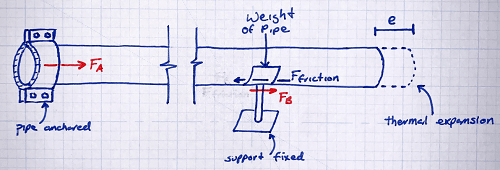Hi All,
I am trying to figure out the anchor force on a pipe given thermal expansion.
with one side of the pipe anchored and the other side free to expand given a temperature increase. (see photo above)
Let’s say the pipe supports are fixed to the ground and the pipe can slide over the supports.
This generates a friction force which is:
friction force = (the weight the support holds) x (friction factor between the pipe and the support, both kinetic and static)
My question is this: does the pipe anchor feel the reaction of that friction force or does the support or both and how to look at that?
I am trying to figure out the anchor force on a pipe given thermal expansion.
with one side of the pipe anchored and the other side free to expand given a temperature increase. (see photo above)
Let’s say the pipe supports are fixed to the ground and the pipe can slide over the supports.
This generates a friction force which is:
friction force = (the weight the support holds) x (friction factor between the pipe and the support, both kinetic and static)
My question is this: does the pipe anchor feel the reaction of that friction force or does the support or both and how to look at that?

